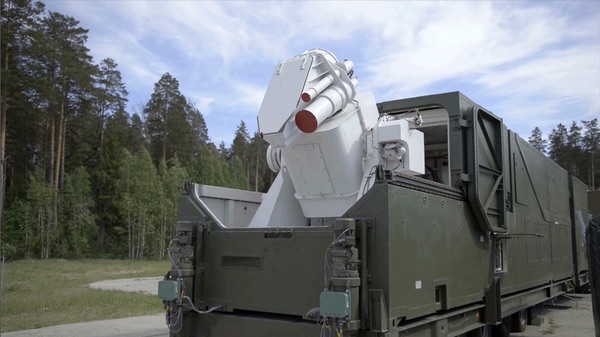Peresvet: a Russian mobile laser system to dazzle enemy satellitesby Bart Hendrickx
|
| In response to Putin’s invitation to think up a name for the laser complex, a public vote was held which resulted in the system being called Peresvet, which is a photographic term meaning “overexposure”, but also refers to a 14th century Russian Orthodox warrior monk named Aleksandr Peresvet. |
In July 2018, the Ministry of Defense released another video of Peresvet on its YouTube channel.[2] The accompanying press release disclosed nothing about the system’s purpose, but said that Peresvet laser trucks had been moved to their deployment sites and were undergoing preparations “to enter combat duty.” It also revealed that the system’s operators had undergone training at the Mozhaiskiy Military Space Academy in St. Petersburg, pointing to a possible space-related role for the system. One of the features seen in the video was a shelter for Peresvet with a mobile extension mounted on rails.
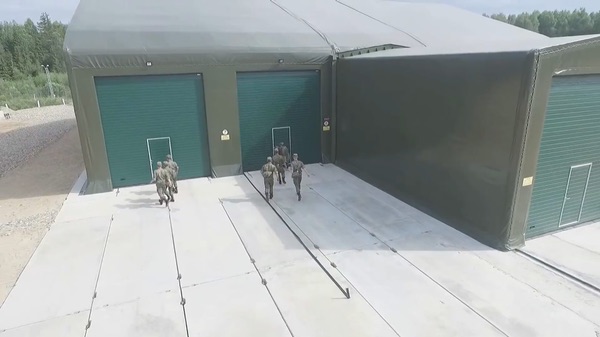 Shelter for Peresvet seen in a Ministry of Defense video released in July 2018. |
Within weeks, amateur researchers studying satellite imagery on Google Earth found that the shelters were located at bases of the Strategic Missile Forces operating road-mobile intercontinental ballistic missiles. More specifically, the shelters were seen at ICBM garrisons near Teykovo, Yoshkar-Ola, and Novosbirsk, with some of the imagery showing Peresvet laser trucks parked outside.[3]
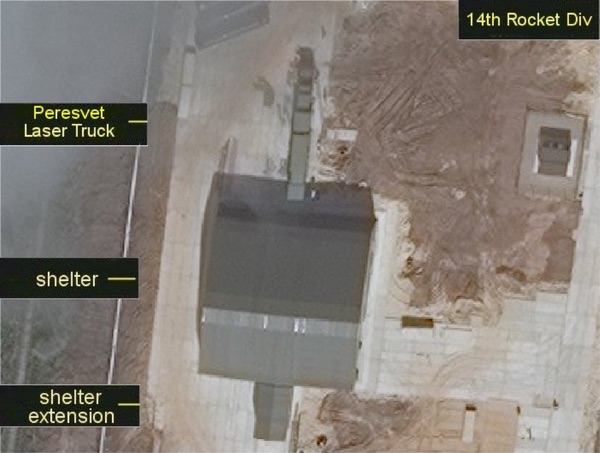 Peresvet laser truck seen outside its shelter at the 14th Missile Division near Yoshkar-Ola. (credit: military.russia.ru) |
All of these bases have been or are being armed with mobile versions of a new-generation ICBM called Yars, also known as Topol-MR and RS-24, with the NATO reporting name being SS-29 or SS-27 Mod 2. First tested in 2007, this is a three-stage solid-fuel missile with an operational range of between 11,000 and 12,000 kilometers and outfitted with independently targetable warheads. It is gradually replacing the older Topol-M, which was the first new ICBM to enter service after the collapse of the Soviet Union.
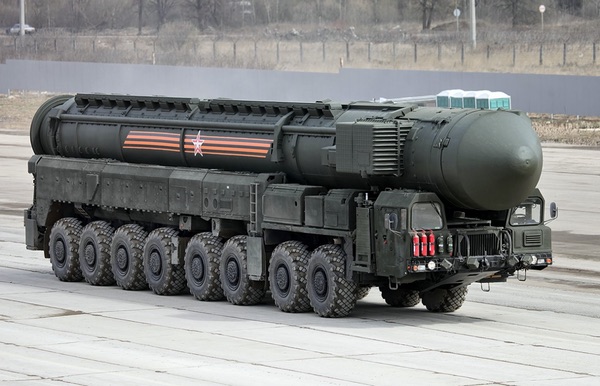 RS-24/Yars ICBM on its transporter erector launcher. (credit: Vitaliy Kuzmin) |
The discovery that the laser trucks were based at ICBM sites made it possible to narrow down the possible objectives of Peresvet. Most analysts agreed that it was probably not powerful enough to physically destroy targets, but was designed to damage optical systems of vehicles trying to attack or image mobile ICBMs: aircraft, drones, cruise missiles, or satellites. The latter were considered by many to be the most likely targets for Peresvet. If imaging satellites are blinded by a laser beam, an adversary would be denied the opportunity to follow the movements of mobile ICBMs. This would come in handy if there were signs of an imminent attack on Russia’s ICBM arsenal or if Russia itself had the intention to launch a nuclear first strike on another nation. The speculation focused both on optical reconnaissance satellites and missile early warning satellites.
The idea of using lasers to target optical systems of satellites has been discussed for many years in literature on counterspace technology. A distinction is usually made between “dazzling” and “blinding”. Dazzling causes sensors to temporarily lose their imaging capability by swamping them with light that is brighter than what they are trying to image. Blinding inflicts permanent damage to such systems. Since imaging sensors are very sensitive to light, only relatively low power levels are needed to achieve these goals.[4] The country believed to have made the most significant progress in this field is China, which may even have tested laser dazzling technology on US satellites in the mid-2000s.
Speculation on a possible ASAT role for Peresvet was further supported by the fact that two patents which likely described elements of the system said it was designed to monitor and clean up space debris.[5]
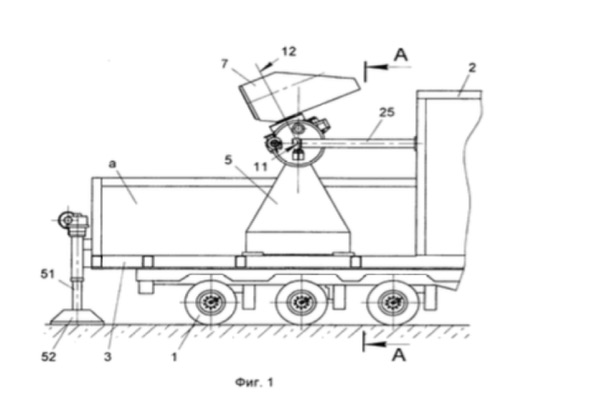 Drawing from a 2015 RFYaTs-VNIIEF patent for what was described as a “mobile optical telescope”. |
The patents, which appeared online in 2013 and 2015, also made it possible to identify what likely was the prime contractor for Peresvet. They were published by an institute called the Russian Federal Nuclear Center – All-Russian Scientific Research Institute of Experimental Physics (RFYaTs-VNIIEF or РФЯЦ-ВНИИЭФ in Cyrillic), which is based in Sarov (formerly Arzamas-16), a military town with restricted access in the Nizhniy Novgorod region some 500 kilometers east of Moscow. Operating under the wings of the Rosatom State Atomic Energy Corporation, this was established back in the 1940s as the Soviet Union’s leading research and development center for nuclear weapons. However, it also has departments specializing in other fields, including an Institute of Laser Physics (ILFI) that has done extensive research in the field of laser physics and technology. It is currently building UFL-2M, described as the world’s most powerful laser research facility. ILFI’s director Sergei Garanin, a renowned Russian laser expert, was involved in both of the aforementioned patents.
Conclusive evidence for RFYaTS-VNIIEF’s involvement in Peresvet came early last year when Michael Duitsman, a research associate at the Middlebury Institute of International Studies at Monterey, spotted one of the Peresvet trucks on Google Earth as it was being wheeled out of a hangar at the institute’s test complex.[6]
| Information recently released by a subcontractor has now provided the key to finding documentary evidence for Peresvet’s ASAT role. |
In December 2018, the Russian Ministry of Defense released another video of the trailer-mounted laser system on Facebook. The accompanying statement said that Peresvet had entered “experimental combat duty” and could “efficiently counter any aerial attack and even fight satellites in orbit,” which was the first official acknowledgment that Peresvet has an ASAT capability. The information was removed less than an hour after it appeared online, suggesting it was released by accident.[7] Late last year, the Chief of the General Staff of Russia’s Armed Forces Valeriy Gerasimov confirmed that Peresvet’s task is to “conceal the movements” of mobile missile systems.[8] Defense Minister Sergei Shoigu announced somewhat later that Peresvet had been declared operational at five missile divisions on December 1, 2019.[9]
Peresvet in official documentation
Despite all the circumstantial evidence and the Ministry of Defense’s statement on Facebook, the total absence of publicly accessible official documents related to the project has made it impossible to verify if Peresvet indeed has a counterspace capability. Complicating the search for such documents is that they are unlikely to contain the project’s public name, which didn’t even exist before it was chosen by popular vote in early 2018. Considering the fact that Peresvet was declared operational in December 2019, the project must have started well before 2018.
Information recently released by a subcontractor has now provided the key to finding documentary evidence for Peresvet’s ASAT role and obtaining a better understanding of the project’s history and organizational background. The subcontractor, called the Design Bureau of Special Machine Building (KBSM) and based in St. Petersburg, is in charge of building Peresvet’s pointing mechanism, which is crucial to keep the laser beam accurately aimed at its target. The fact that KBSM has a role in Peresvet could already be deduced from the aforementioned 2015 patent, which was co-authored by several of the company’s specialists. A brochure published by KBSM in the same year confirmed its involvement in the development of a “mobile optical telescope to observe space objects.”[10] In a recent article, KBSM’s general director Vladimir Dolbenkov called the mobile optical telescope SM-890 (although that seems to be the code name for the pointing mechanism rather than the telescope itself) and said it was intended for what he called “article 14Ts034” (14Ц034 in Cyrillic), which clearly is Peresvet’s official Ministry of Defense designator.[11]
By using this designator rather than the public name, Dolbenkov was apparently trying to conceal the project that the telescope is intended for, but in doing so inadvertently opened the door to finding key information on the project in official documents that are openly available online. The 14Ts034 designator shows up in several court cases between organizations involved in the project and these in turn make it possible to expand the search for tender documentation and contracts related to Peresvet on Russia’s government procurement website.
Two of the court cases (in 2017–2018) were between the Ministry of Defense and a company called MAK Vympel, which plays a leading role in the development of the country’s ground-based space surveillance network.[12] The associated documents mention communication systems needed to link 14Ts034 with what is described as “Object 3006M”. This is known from other sources to be a code name for the 821st Main Space Reconnaissance Center, Russia’s space surveillance headquarters in Noginsk-9 (also known as Dubrovo), a small military town about 60 kilometers east of Moscow. This leaves little doubt that the center will forward satellite tracking data that it receives from a network of space surveillance radars and optical telescopes across Russia to Peresvet laser combat units in the field. The documents also mention similar communication links between the space surveillance headquarters and 14Ts033 (14Ц033 in Cyrillic), which is the designator of a missile called Nudol that has made at least ten test flights from a transporter erector launcher at the Plesetsk launch site in northwestern Russia. This clearly shows that Nudol is supposed to receive targeting data from the space surveillance headquarters, confirming speculation that it is a direct-ascent anti-satellite system.
The 14Ts034 designator is also seen in court documentation published in 2019 in which the Ministry of Defense sues RFYaTs-VNIIEF for not having met certain obligations under a project called Stuzha-RN, for which the two parties signed a contract on December 4, 2012.[13] The goal of Stuzha-RN was to finish R&D work on what is literally called a “mobile complex to suppress electro-optical reconnaissance satellites and dual-use Earth remote sensing satellites.” This is unmistakable evidence that dazzling and/or blinding of satellite optical systems is at least one of Peresvet’s objectives, the targets being optical reconnaissance satellites and remote sensing satellites used both for civilian and military purposes (which is what is meant by “dual-use”.) These orbit the Earth in relatively low, high-inclination orbits and would be easier targets for a laser system than early warning satellites, most of which operate in geostationary orbit.
| The exact type of high-power laser used by Peresvet remains known. |
It is not clear if Stuzha (which means “severe cold”) is another secret Ministry of Defense name for Peresvet or refers only to one particular R&D phase of the project. The name also appears in a brochure released by RFYaTs-VNIIEF in 2014.[14] This says that the institute had built a “compact multifunctional super computer” for Stuzha-RN identified as “Shtorm” (“Storm”). This was put on display at a Ministry of Defense exhibition in 2015, but its purpose was not revealed. All that was disclosed about it was that it was built to withstand extreme temperatures, dust, vibrations, and humidity and had a built-in safety system that would delete all information from its magnetic memory disks “in emergency situations.”[15] With hindsight, it would seem to be a computer system intended to control the Peresvet complex and designed to operate in the harsh conditions that Peresvet may encounter in the field.
Other recent court documentation that can be linked to Peresvet refers to a government contract signed between the Ministry of Defense and RFYaTs-VNIIEF on September 2, 2010.[16] This may very well be the contract that officially started the project and gave the institute the go-ahead to initiate R&D work and look for industrial partners to participate in the project. The December 2012 contract then apparently ordered RFYaTS-VNIIEF to complete the R&D phase, a goal that, judging from the documentation, seems to have been accomplished in 2015, a year later than originally planned.
Yet another recent court document mentions a contract signed by KBSM in 2015 related to the SM-890 pointing system. [17] The information provided here makes it possible to find tender documentation on Russia’s government procurement website which shows that the Ministry of Defense signed two more follow-up contracts with RFYaTs-VNIIEF on October 17, 2015 and March 25, 2016. These presumably laid out plans for the operational deployment of the laser system.
KBSM is seen in the procurement documentation as a subcontractor to PO Start, another company subordinate to Rosatom which is situated in Zarechnyy (Penza region). Both seem to have a role in developing the SM-890 pointing mechanism, but the exact division of labor between the two is not clear. Many of the documents also mention components named SM-893 and SM-894, but their purpose is unknown.[18]
Another key subcontractor to RFYaTs-VNIIEF that can be identified from this documentation is NII NPO Luch in Podolsk (Moscow region), yet another organization belonging to Rosatom. It is responsible for an adaptive optics system needed to compensate for atmospheric turbulence that the laser beam encounters on its way to space.[19] Adaptive optics systems typically use a beacon illuminator laser that creates an artificial guide star by shining a low-power laser into the atmosphere. Light from the beam is then reflected back by components in the upper atmosphere and measured by a so-called wavefront sensor that determines atmospheric turbulence between the laser complex and the target. This information is then used to drive the adaptive optics, which consist of one or more deformable mirrors that can adjust the high-power laser beam that is subsequently aimed at the target. The use of an adaptive optics system also reduces the time that the laser needs to be maintained on the target to achieve its goal. Peresvet’s adaptive optics system may be described in a patent published by NII NPO Luch in 2018.[20]
The exact type of high-power laser used by Peresvet remains known. One Russian analyst recently concluded that the most likely type was a nuclear-pumped laser, among other things because of RFYaTs-VNIIEF’s close involvement in the country’s nuclear weapons program.[21] Another recent Russian article, citing only “scientific forums,” says Peresvet most likely uses an explosively pumped iodine photodissociation laser, a type of laser in which a detonator is activated to dissociate perfluoroalkalyl iodides in the gain medium and raise the resulting iodine atoms to the energy levels needed to produce a laser beam.[22] RFYaTs-VNIIEF has a long history experimenting with this type of laser and considered it for use in the Soviet-era Terra-3 laser complex, an anti-missile laser system that never reached operational status. It is also the one recommended for use in the 2013 RFYaTs-VNIIEF patent that is likely related to Peresvet. The patent holders, several of whom have a background in the development of this type of laser, claim it has a longer range than two other types that could potentially be used, namely alkali metal vapor lasers and fiber lasers. The reasons given for that are its ability to work in pulsed rather than continuous wave mode and its operating wavelength (1.315 µm, in the near infrared), which allows the beam to easily pass through the atmosphere.
However, the power levels of explosively pumped iodine lasers given in scientific literature far exceed the ones that would be required for the simple dazzling or blinding of sensors, raising the question why they would be needed for a system like Peresvet. Some articles also describe them as single-shot lasers, although RFYaTs-VNIIEF does seem to have made efforts to enable multiple firings of such lasers.
| In a newspaper interview last December, Russian Deputy Defense Minister Aleksey Krivoruchko said that the capabilities of Peresvet will be further expanded “in the coming years” by placing it on board “an airborne carrier.” |
Peresvet uses a KAMAZ-65225 tractor unit and a ChMZAP-99903 semi-trailer carrying several containers. In one of the court documents these are called the technological container, environmental control container, equipment container, and support container. The laser and its telescope are mounted in the aft container (likely the “equipment container”), which has a sliding roof. The videos also show several support vehicles accompanying the laser truck, at least one of which is used as a command post and another to supply power to the laser. In May 2018 Deputy Defense Minister Yuriy Borisov told the military Zvezda TV channel that Peresvet was being modernized and that future versions would be more compact and require fewer support vehicles.[23]
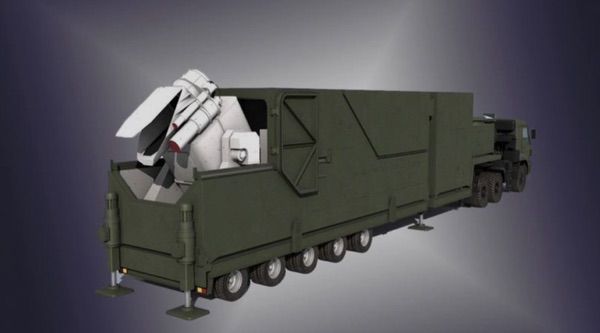 Drawing of Peresvet’s laser truck. (credit: Voennoe obozrenie) |
Work is also continuing on ground support facilities for Peresvet under contracts signed between the Ministry of Defense and the military construction company GVSU 5 on October 10, 2017 and June 14, 2018. This can be inferred from contracts published on Russia’s government procurement website, which contain the 14Ts034 designator and refer to the facilities with the designator “2146”.[24] Four of Peresvet’s home bases can now be positively identified from the available contracts:
- 2146/1: at the 54th Missile Division near Teykovo
- 2146/2: at the 39th Missile Division near Novosibirsk
- 2146/3: at the 35th Missile Division near Barnaul
- 2146/5: at the 14th Missile Division near Yoshkar-Ola
The existence of the Peresvet site near Barnaul (in the Altai region) was not known earlier. The laser truck shelter with its telltale mobile extension can be seen on Google Earth just west of the closed military town of Sibirskiy, situated about 25 kilometers north of Barnaul. The location of one of the sites (2146/4) remains unknown at the present time. The only other regiments that are being armed with road-mobile Yars missiles are the 29th Missile Division near Irkutsk and the 42th Missile Division near Nizhniy Tagil, but presently available imagery does not show the truck shelter in either location.
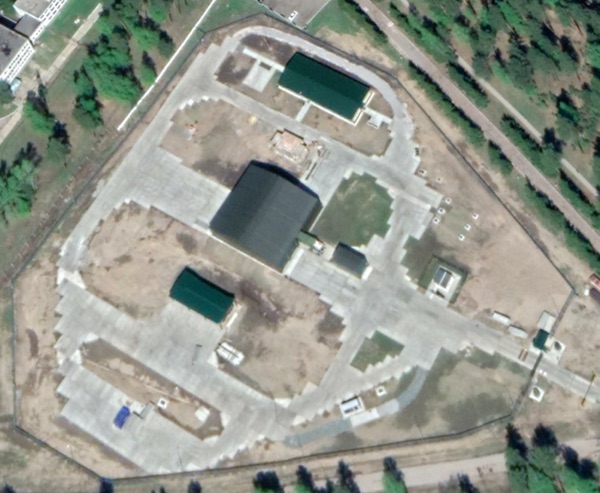 Google Earth image of Peresvet site 2146/3 near Barnaul. The mobile extension has been moved backward, exposing what seems to be the aft section of the laser truck with its white laser telescope. |
Sokol-Eshelon
In a newspaper interview last December, Russian Deputy Defense Minister Aleksey Krivoruchko said that the capabilities of Peresvet will be further expanded “in the coming years” by placing it on board “an airborne carrier.”[25] This came as a total surprise, because Russia has been working since early this century on another airborne laser system called Sokol-Eshelon (“Falcon-Echelon”) that likely has ASAT goals. The project officially got underway on December 23, 2002, with the signing of a government contract between the Ministry of Defense and NPO Almaz, the prime contractor. Initially, Sokol-Eshelon used a modified Ilyushin-76MD transport aircraft originally built for a Soviet-era laser project called Ladoga that appears to have been mainly intended to knock out airborne targets such as balloons (speculation on a space-related role has never been confirmed). The aircraft has also been called the Beriev A-60, because it was modified for that purpose by the Beriev design bureau in Taganrog.
Sokol-Eshelon has been largely shrouded in secrecy, but its chief designer Aleksandr Ignatyev did give some background on it in press interviews in 2010 and 2014, without mentioning the project’s name. He said the resumption of the airborne laser tests after the turn of the century was part of the Russian response to America’s withdrawal from the ABM Treaty in June 2002. He stressed that the Russian project had different objectives than the equivalent American YAL-1 Airborne Laser Testbed, an Air Force project started in 1996 and canceled in 2011. This was aimed at physically destroying ballistic missiles, whereas the Russian system, in Ignatyev’s words, was designed to “counter air-based and space-based reconnaissance assets in the infrared part of the spectrum,” an apparent reference to dazzling and/or blinding. This requires lasers with much lower energy and is therefore less expensive. The type of laser selected for Sokol-Eshelon was a carbon monoxide laser. Advantages of airborne laser ASAT systems are that they have more flexibility in the choice of targets and that the laser is not hampered by weather conditions.
The Beriev A-60 flew a number of test flights in the first decade of this century. These were intended to detect and track satellites and aim laser beams at them. In one of the tests, conducted on August 28, 2009, the aircraft fired a laser beam at a Japanese geodetic satellite called Ajisaj. The test was not designed to damage the satellite, but rather took advantage of the presence of corner reflectors on the satellite to test the targeting system against a satellite in a known orbital path. Underscoring its primary objective, the airplane had an emblem showing a laser beam hitting the Hubble Space Telescope, which was apparently supposed to represent a KH-11 reconnaissance satellite, believed to have a design similar to HST.
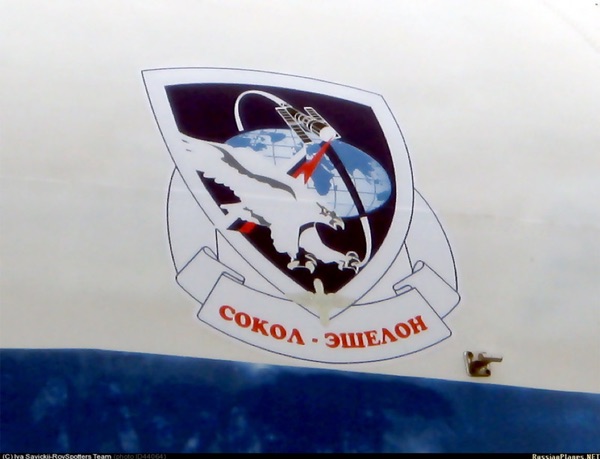 Insignia on the original aircraft used for the Sokol-Eshelon project. (credit: Ivan Savitskiy) |
Press reports suggest the project was on the verge of cancelation at the beginning of last decade, but somehow managed to survive. A new Ilyushin-76 aircraft (a modified Il-76MD-90A with serial number 0104 and tail number RF-78652) was commissioned to continue test flights under the project. It was officially handed over to the Ministry of Defense in April 2015, but at that point still needed to be outfitted with the laser complex.
Despite the delivery of the new aircraft, it would seem that the project’s fate continued to hang by a thread throughout the decade. One court document published in mid-2018 even said that the Ministry of Defense had decided to terminate work on Sokol-Eshelon in late 2017. However, contracts signed as part of the project continued to appear on Russia’s government procurement website afterwards. Moreover, it was still mentioned as a high-priority project in NPO Almaz’s annual report for 2018, the latest one available online.[26]
Earlier this year, the Beriev design bureau published a patent called “Carrier aircraft for an air-based laser complex” that is likely related to Sokol-Eshelon. The patent’s technical description is not available online, but the drawings accompanying the patent are.[27] They show what appears to be an Il-76MD-90A aircraft with a drop-shaped housing for a laser complex mounted just behind the roof of the cockpit. This may be what the newly commissioned aircraft will look like after the modification work is completed.
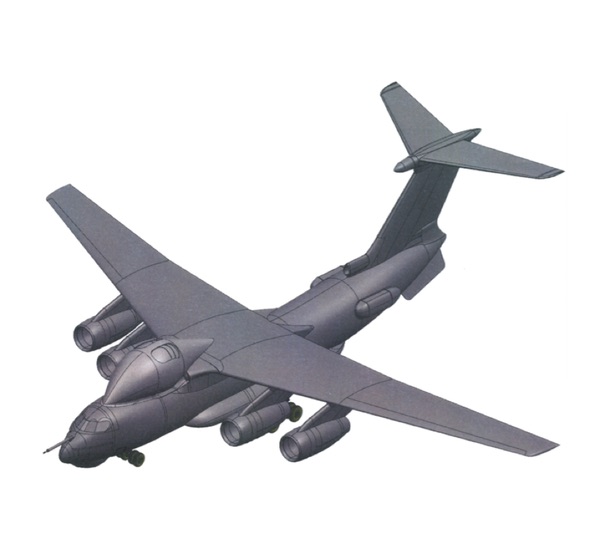 Drawing from a 2020 patent of the Beriev design bureau. |
Currently available information does not point to any links between Sokol-Eshelon and Peresvet. Sokol-Eshelon and Peresvet are run by two different organizations (NPO Almaz and RFYaTs-VNIIEF) with different industrial partners. The projects seem to use fundamentally different laser systems and recent contracts signed under Sokol-Eshelon continue to refer to the government contract that started the project in 2002. If Sokol-Eshelon had undergone any fundamental changes to incorporate elements of Peresvet, that likely would have necessitated the signing of a new government contract.
| If Sokol-Eshelon and Peresvet’s air-based version are indeed two different projects, it is unlikely that both will have ASAT objectives. |
It is not impossible that with “Peresvet’s airborne version” Krivoruchko was simply referring to Sokol-Eshelon itself, without mentioning it by name. This, however, is contradicted by the fact that NII NPO Luch, an organization with no known involvement in Sokol-Eshelon, has recently published papers on adaptive optics systems for laser-equipped aircraft, a possible sign that it is modifying the technology it developed for Peresvet for use on a carrier aircraft[28]. Judging from procurement documentation, the company has been working on a new adaptive optics system called “F-AOS” under a contract signed with RFYaTs-VNIIEF on May 30, 2017, which in turn may be based on a government contract concluded between the latter and the Ministry of Defense on April 1, 2017. However, it cannot be determined with certainty at this point if this bears any relation to Peresvet or its airborne version.
If Sokol-Eshelon and Peresvet’s air-based version are indeed two different projects, it is unlikely that both will have ASAT objectives. Any airborne version of Peresvet will clearly not have the same point-defense role as its ground-based equivalent. A recently published Russian analysis did not rule out a counterspace role for the air-based Peresvet, but concluded that its most important user will likely be the Russian Air Force, which could use it as an anti-aircraft weapon. A laser system would offer several advantages over air-to-air missiles, notably its longer range and the enemy’s inability to defend its aircraft from laser attacks.[29]. Further complicating the picture is Krivoruchko’s claim in the same interview that Russia is outfitting aircraft with laser systems (not related to Peresvet) to protect them from surface-to-air and air-to-air missiles.
Kalina
If all this weren’t enough, Russia has also been working on a stationary ground-based capability to dazzle or blind satellite sensors using an optical/laser space surveillance facility in the North Caucasus. The facility is part of the Krona complex, situated on the Chapal mountain near Storozhevaya. Krona consists of a radar installation to identify satellites and categorize them by type and a so-called “laser optical locator” (LOL), comprising a 0.4-meter wide-angle telescope for the detection of satellites in high orbits, a 1.3-meter narrow-angle telescope with adaptive optics for high-resolution imaging of satellites in low orbits, and a lidar (also called the “transmit-receive channel”) used to accurately measure distances to satellites.
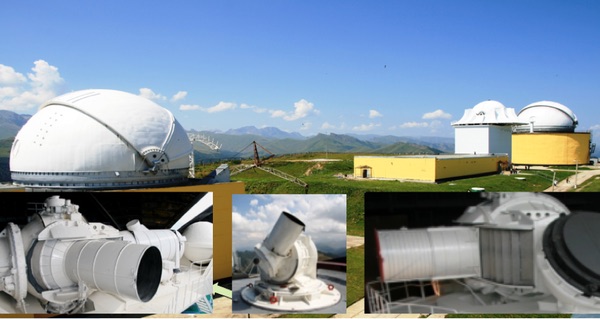 Krona’s laser optical locator on the Chapal mountain. (credit: NPK SPP) |
Early last decade work got underway on upgrading the laser complex under a project code-named Kalina (“guelder rose”), led by the Scientific and Industrial Corporation “Precision Instrument Systems” (NPK SPP). The company signed a contract for Kalina (also called 30Zh6MK or 30Ж6МК in Cyrillic) with the Ministry of Defense on November 3, 2011.
A bank guarantee document placed online in January 2014 described Kalina’s goal as “the creation of a channel for the functional suppression of electro-optical systems of satellites… using solid-state lasers and a transmit/receive adaptive optics system.”[30] Further evidence for Kalina’s ASAT role came in NPK SPP’s annual report for 2013, which mentioned its involvement in the development of “laser systems for electro-optical warfare.”[31] In addition to that, one document (no longer online) described Kalina as a “space security complex,” a term also used in official documentation for another ASAT project, namely the air-launched Burevestnik system.
A building contract for Kalina awarded by the Ministry of Defense on November 20, 2015, refers to the construction site as “Object 4737-K2” and also mentions a component named “channel 14Ts235” (14Ц235 in Cyrillic), which looks like a designator for the satellite blinding system.[32] There is no sign on Google Earth of any major new construction in the vicinity of the Krona LOL site, which would indicate that the existing laser system is being adapted for the counterspace role. However, it is unclear how far that work has progressed.
Conclusions
Strong indications that the Peresvet laser complex unveiled by President Putin in March 2018 has an anti-satellite role have now been confirmed by documentary evidence. The system is designed to conceal the movements of road-mobile ICBMs by temporarily dazzling or permanently blinding optical systems of enemy reconnaissance satellites. Dazzling is a more likely objective than blinding because the laser systems are located close to the targets they are intended to protect, suggesting they are only needed to temporarily affect the imaging capabilities of reconnaissance satellites while they are passing over the area of interest. While questions may be asked about the wisdom of investing huge sums of money in such a capability, the current evidence points to this being Peresvet’s primary goal. The Russian Ministry of Defense’s claim that Peresvet also offers protection against aerial attacks is so far not corroborated by the available official documents. In fact, enemy aircraft or drones are unlikely to present an immediate threat to Russia’s road-mobile ICBMs, which are based deep inside the country.
Russian officials have stated that Peresvet is an operational system, which, if true, means that it may well have been tested in conjunction with Russian satellites and has overcome significant technical challenges such as the development of sophisticated adaptive optics and pointing control systems to aim laser beams at fast moving orbiting targets.
Russia has also been working for many years on a capability to dazzle/blind satellites using an air-based laser system (Sokol-Eshelon) and a ground-based stationary laser system (Kalina). Sokol-Eshelon has barely managed to survive and is still very much an experimental program that is probably several years away from becoming operational. The jury is still out on whether the recently announced airborne version of Peresvet is a different project and, if so, for what purpose it will be used. The current status of Kalina is unknown. Sokol-Eshelon and Kalina are clearly not point-defense systems like Peresvet, indicating their primary task may be blinding rather than dazzling.
| All in all, the country seems to be building up a counterspace capability unmatched by that of any other nation. |
Whatever the rationale for having at least three separate satellite dazzling/blinding systems, Russia clearly has a major interest in this type of directed energy counterspace technology, which has the advantage that it produces no space debris and may make it hard for the adversary to prove that its satellites have been affected or damaged as the result of a hostile act. The country also seems to have invested in both ground-based and space-based electronic warfare systems against satellites, another type of non-destructive counterspace technology. Still, all this has not stopped Russia from also developing more conventional kinetic ASAT weapons like the ground-launched Nudol and the air-launched Burevestnik systems.
All in all, the country seems to be building up a counterspace capability unmatched by that of any other nation. The multitude of ASAT systems is possibly seen as a deterrent against the growing military space capabilities of both the United States and China, which over the past decade have fielded a fleet of military satellites far outnumbering those of Russia. Many Russian military space projects have experienced significant delays, not in the least due to Western-imposed economic sanctions that have significantly hampered the import of electronic components needed by the country’s space industry. In a way, the current build-up of Russian ASAT systems is reminiscent of that in the 1980s, when the Soviet Union worked on a variety of ground-based, air-based and space-based counterspace weapons as part of what it called its asymmetric response to America’s Strategic Defense Initiative, which was aimed at creating a space-based shield against incoming Soviet missiles. The only thing that stopped the Soviet Union from deploying those systems back then was the end of the Cold War. With US-Russian relations now at a post-Cold War low and no improvement in sight, nothing seems to be standing in the way of such systems becoming operational this time around.
References
- The part of Putin’s speech devoted to Peresvet and the accompanying video can be seen here.
- Video released by the Ministry of Defense on July 19, 2018.
- See this thread on the Russian-language forum military.russia.ru.
- For more background on dazzling and blinding, see: D. Wright, L. Grego, L. Gronlund, The Physics of Space Security: A Reference Manual, American Academy of Arts and Sciences, 2005.
- “Laser device for control over near-Earth space”, patent published by RFYaTS-VNIIEF in 2013 ; “Mobile optical telescope”, patent published by RFYaTs-VNIIEF in 2015 (the links are to English machine translations of the patents).
- The images found by Michael Duitsman can be seen here.
- The original Facebook statement and its edited version (in Russian) as well as the accompanying video of Peresvet can be seen here.
- A. Tikhonov, “Russia’s Defense Minister is prepared for an equal dialogue on military security issues” (in Russian), Krasnaya zvezda, December 18, 2019, p. 1.
- RIA Novosti report, December 24, 2019.
- KBSM brochure, 2015, p. 62.
- V. Dolbenkov, “75th anniversary of AO KBSM” (in Russian), Natsionalnaya Oborona, March 2020.
- Documents (in Russian) published in 2017 and 2018 describing court cases between the Ministry of Defense and MAK Vympel.
- Documents (in Russian) published in late 2018/early 2019 describing a court case between the Ministry of Defense and RFYaTS-VNIIEF. Peresvet is mistakenly referred to here as 14Ts34 (instead of 14Ts034).
- RFYaTS-VNIIEF brochure (in Russian), 2014, p. 12.
- RFYaTS-VNIIEF press release (in Russian), October 1, 2015.
- Documents (in Russian) published in late 2019/early 2020 describing a court case between KBSM and AO Asteis.
- Documents (in Russian) published in late 2019/early 2020 describing a court case between KBSM and AO Asteis.
- One example of a contract signed between PO Start and KBSM is here.
- One example of a contract signed by NII NPO Luch for the adaptive optics system is here.
- “Adaptive mirror” (in Russian), patent published by NII NPO Luch in 2018.
- A. Mitrofanov, “Secrets of the Peresvet complex: how does the Russian laser sword work?”, Voennoe obozrenie, February 3, 2020.
- V. Teslenko, “Flying combat laser” (in Russian), Kommersant, March 17, 2020.
- Interview (in Russian) with Yuriy Borisov, Zvezda TV, May 5, 2018.
- Contracts for Peresvet sites 2146/1, 2146/2, 2146/3 and 2146/5.
- Interview (in Russian) with Aleksey Krivoruchko, Krasnaya zvezda, December 28, 2019, p. 5.
- For more on Sokol-Eshelon, see: D. Day, “Hubble in the crosshairs”, The Space Review , June 13, 2011 ; a summary of the currently available information with links to sources of information can be found in this thread on the NASA Spaceflight Forum.
- Patent published by the Beriev design bureau in 2020 (drawings only accessible for registered users of the elibrary.ru website).
- One of the NII NPO Luch articles on adaptive optics for laser-equipped aircraft (in Russian with an English abstract) is here.
- A. Mitrofanov, Aviation performance of the Peresvet combat laser system: carriers, targets, tactics of application, Voennoe obozrenie, February 28, 2020.
- Bank guarantee document (in Russian) placed online in January 2014.
- NPK SPP’s 2013 annual report (in Russian), p. 51-52.
- Documents (in Russian) published in 2019 describing a court case between the Ministry of Defense and the military construction company 31 GPISS. For more on Kalina, see this thread on the NASA Spaceflight Forum.
Note: we are temporarily moderating all comments submitted to deal with a surge in spam.
